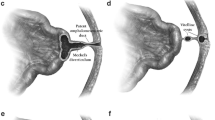Abstract
Background
Meckel diverticulum is one of the most important causes of small bowel bleeding in children. Reports suggest that ultrasonography can be used as an alternative examination for children with negative radionuclide scanning results or children with atypical clinical manifestations.
Objective
To evaluate the diagnostic accuracy of high-frequency ultrasound in children with bleeding Meckel diverticulum.
Materials and methods
We collected the data of children who were admitted to our hospital for the main symptom of bloody stool from February 2006 to December 2017. Ultrasonography was performed in all children. The final diagnosis was confirmed by pathological analysis or clinical follow-up observation. We evaluated the diagnostic performance of ultrasonography according to the final diagnosis.
Results
A total of 784 eligible children were enrolled in the study. Presenting symptoms or findings included black and red stool in 528 (67.3%), bright red stool in 51 (6.5%) and obscure or occult bloody stool in 205 (26.1%). Anemia was diagnosed in 489 (62.4%). Ultrasonography diagnosed Meckel diverticulum with a sensitivity of 93.6% (95% confidence interval [CI] 91.0–95.6%) and a specificity of 98.1% (95% CI 95.9–99.3%).
Conclusion
High-frequency ultrasound diagnosis of Meckel diverticulum in children has high sensitivity and specificity.






Similar content being viewed by others
References
Robinson JR, Correa H, Brinkman AS et al (2017) Optimizing surgical resection of the bleeding Meckel diverticulum in children. J Pediatr Surg 52:1610–1615
Blevrakis E, Partalis N, Seremeti C et al (2011) Meckel diverticulum in pediatric practice on Crete (Greece): a 10-year review. Afr J Paediatr Surg 8:279–282
Malik AA, Wani KA, Khaja AR (2010) Meckel diverticulum-revisited. Saudi J Gastroenterol 16:3–7
Daneman A, Lobo E, Alton DJ et al (1998) The value of sonography: CT and air enema for detection of complicated Meckel diverticulum in children with nonspecific clinical presentation. Pediatr Radiol 28:928–932
Baldisserotto M, Maffazzoni DR, Dora MD (2003) Sonographic findings of Meckel’s diverticulitis in children. AJR Am J Roentgenol 180:425–428
Lin XK, Huang XZ, Bao XZ et al (2017) Clinical characteristics of Meckel diverticulum in children: a retrospective review of a 15-year single-center experience. Medicine 96:e7760
Burjonrappa S, Khaing P (2014) Meckel diverticulum and ectopic epithelium: evaluation of a complex relationship. J Indian Assoc Pediatr Surg 19:85–89
Irvine I, Doherty A, Hayes R (2017) Bleeding Meckel diverticulum: a study of the accuracy of pertechnetate scintigraphy as a diagnostic tool. Eur J Radiol 96:27–30
Wu H, Zhao X, Li Y et al (2017) Reconsideration of the primary and secondary diagnostic criteria of Meckel diverticulum scintigraphy. A study of 93 confirmed cases. Hell J Nucl Med 20:11–16
Cohen S, Oliva S (2015) Capsule endoscopy in pediatrics: a growing experience. Tech Gastrointest Endosc 17:31–36
Konomatsu K, Kuwai T, Yamaguchi T et al (2017) Endoscopic full-thickness resection for inverted Meckel′s diverticulum using double-balloon enteroscopy. Endoscopy 49:E66–E67
Sahn B, Bitton S (2016) Lower gastrointestinal bleeding in children. Gastrointest Endosc Clin N Am 26:75–98
Kawamoto S, Raman SP, Blackford A et al (2015) CT detection of symptomatic and asymptomatic Meckel diverticulum. AJR Am J Roentgenol 205:281–291
Casciani E, Nardo GD, Chin S et al (2017) MR enterography in paediatric patients with obscure gastrointestinal bleeding. Eur J Radiol 93:209–216
Acknowledgments
We thank Angela Morben, DVM, ELS, from Liwen Bianji, Edanz Editing China (www.liwenbianji.cn/ac), for editing the English text of a draft of this manuscript.
Author information
Authors and Affiliations
Corresponding author
Ethics declarations
Conflicts of interest
None
Additional information
Publisher’s note
Springer Nature remains neutral with regard to jurisdictional claims in published maps and institutional affiliations.
Rights and permissions
About this article
Cite this article
Hu, Y., Wang, X., Jia, L. et al. Diagnostic accuracy of high-frequency ultrasound in bleeding Meckel diverticulum in children. Pediatr Radiol 50, 833–839 (2020). https://doi.org/10.1007/s00247-020-04628-x
Received:
Revised:
Accepted:
Published:
Issue Date:
DOI: https://doi.org/10.1007/s00247-020-04628-x




